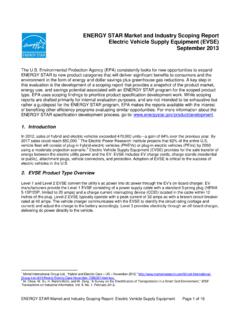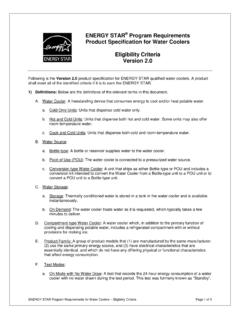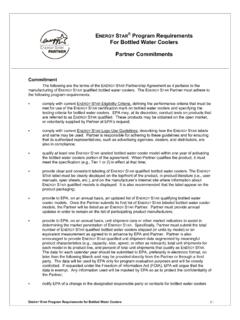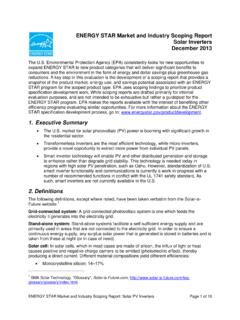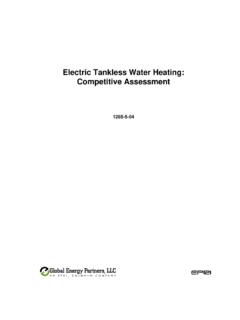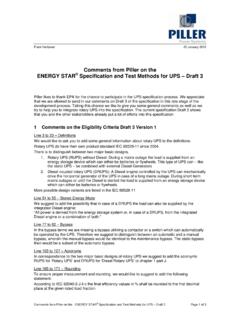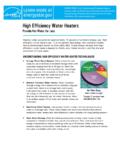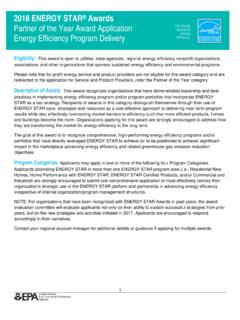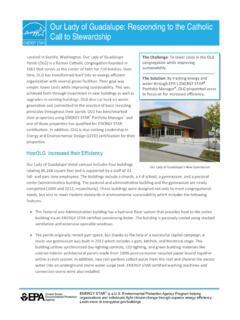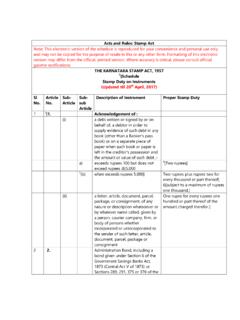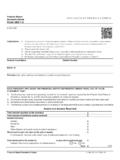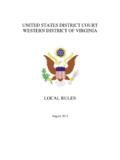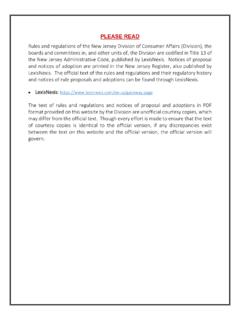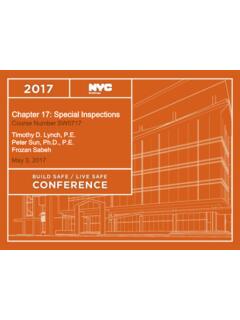Transcription of Advanced Wall Framing - Energy Star
1 Advanced WALLFRAMINGB uild efficiently, use less material, and save Energy !OFFICE OF BUILDING TECHNOLOGY, STATE AND COMMUNITY PROGRAMSENERGY EFFICIENCY AND RENEWABLE Energy DEPARTMENT OF ENERGYB uildings forthe 21st CenturyBuildings that are moreenergy efficient, comfortable,and s thegoal of DOE s Office of BuildingTechnology, State andCommunity Programs (BTS).To accelerate the developmentand wide application of energyefficiency measures, BTS: Conducts R&D on technologiesand concepts for Energy effi-ciency, working closely withthe building industry and withmanufacturers of materials,equipment, and appliances Promotes Energy /moneysaving opportunities to bothbuilders and buyers of homesand commercial buildings Works with state and localregulatory groups to improvebuilding codes, appliance stan-dards.
2 And guidelines for effi-cient Energy use Provides support and grantsto states and communitiesfor deployment of Energy -efficient technologies andpracticesTechnology Fact SheetADVANCED FRAMINGA dvanced Framing refers to a variety of framingtechniques designed to reduce the amount oflumber used and waste generated in the con-struction of a wood-framed techniques include Designing homeson 2-foot mod-ules to makethe best use of common sheet goodsizes and reduce waste and labor. Spacing wall studs up to 24 incheson-center. Spacing floor joists and roof rafters up to24 inches on-center. Using two-stud corner Framing and inex-pensive drywall clips or scrap lumber fordrywall backing instead of studs.
3 Eliminating headers in non-load-bearingwalls. Using in-line Framing in which floor, wall,and roof Framing members are verticallyin line with one another and loads aretransferred directly downward. Using single lumber headers and topplates when Framing techniques, sometimescalled Optimum Value Engineering (OVE), havebeen researched extensively and proven effec-tive. However, some techniques may not beallowed under certain circumstances ( , highwind or seismic potential) or in some certain to consult local building officialsearly in the design phase to verify or obtainacceptance of these FROM ADVANCEDFRAMINGBoth builders and home owners can benefitfrom Advanced Framing .
4 Advanced framingtechniques create a structurally sound homethat has lower material and labor costs than aconventionally framed house. Additional con-struction cost savings result from the genera-tion of less waste that needs to be disposed of,which also helps the Framing improves Energy efficiencyby replacing lumber with insulation whole-wall R-value is improved by reduc-ing thermal bridging through the Framing andmaximizing the wall area that is Framing techniques can be imple-mented individually or as a complete package,depending on the builder. Fully implementingadvanced Framing techniques can result inmaterials cost savings of about $500 or $1000(for a 1,200- and 2,400-square-foot house,respectively), labor cost savings of between 3and 5 percent, and annual heating and coolingcost savings of up to 5 out and cut Framing and sheet goods totake advantage of the full dimension of thematerial.
5 This also reduces job site WALL FRAMINGB ecause wall height is changed when single top plates are used,sheathing and drywall needs are affected. Studs that are 94 inches long (often used for interior walls) do not need to be cutfor use with single top plates, but they are not always lumber needs to be cut to length or requireshaving a strip of drywall added at the bottom of the wall. Pre-cut925/8-inch studs will require ripping approximately 1 inchfrom the sheathing and drywall. If 94 -inch studs are not avail-able, use 925/8-inch studs rather than 96-inch lumber becausethey require less labor and generate less Framing DESIGN CONSIDERATIONSTwo-Foot Module - Design building length, width, and roofpitch in 2-foot increments to make the best use of commonsheet good sizes.
6 This technique will reduce material use, labor,and waste, as many products come in multiples of 2 feet. Forexample, with proper planning, the entire cutoff from a center-cut sheet of plywood can be used elsewhere, eliminating theneed for an additional cut and reducing scrap. When planningthe roof, remember to allow space for a ridge vent if one is Framing - Align floor, wall, and roof Framing membersdirectly above or below one another so that loads are trans-ferred directly downward. With in-line Framing , double topplates can be eliminated because the load is distributed evenlythrough the top plate. Using this method, studs that are 24 inchon-center are placed directly below roof trusses spaced 24inches and Door Layout - Align at least one side of each win-dow and door in line with an existing stud and attach the otherside with a metal hanger.
7 Windows with rough openings of 22 inches can fit between studs that are spaced 24 inches on-center. When this size window is used in conjunction with in-line Framing , headers are not necessary because no studs needto be items - For maximum efficiency, detailed plans shouldshow each piece of wood, cross bracing, and so on in thehouse and locations for all other items such as wiring, ducts,and pipes. Detailed plans will help eliminate conflicts overspace, expedite installation, and eliminate the need to alter ormove studs, joists, or other Framing members '-0"24 inch grid16'- 2"2 strips of plywood4 feet wide and1 strip 2 feet wide9'- 7"19'- 2"18" overhang2'- 10"4'8'16"Plywood soffitPlywood cutting pattern16"2" ventstrip16"16"TWO-FOOT MODULE DESIGN For more information, contact.
8 Energy Efficiency andRenewable EnergyClearinghouse (EREC) visit the BTS Web site refer to the Builder s GuideEnergy Efficient BuildingAssociation, and prepared for Department of Energy by:NAHB Research Energy Department of Energy sOak Ridge National LaboratoryBuildings Technology Department of Energy sNational Renewable International ResidentialCode for One- and Two-FamilyDwellings can be obtained fromthe International Code WALL FRAMINGNOTICE: Neither the UnitedStates government nor anyagency thereof, nor any of theiremployees, makes any warranty,express or implied, or assumesany legal liability or responsibilityfor the accuracy, completeness,or usefulness of any information,apparatus, product, or processdisclosed.
9 The views and opin-ions of authors expressed hereindo not necessarily state or reflectthose of the United States gov-ernment or any agency with a renewable-source ink on paper containing at least50% wastepaper, including 20% postconsumer 2000 DOE/GO-102000-0770 LET-IN BRACINGSHEATHINGN ailbase wooden structural panel sheathing OSB and plywood dominate the installed wood structural wall panels notonly provide resistance to racking (lateral load-ing from wind, seismic, etc.), but also improve the kickable character of many of non-structural insulating rigid foam wallsheathing is another option. It improves en-ergy efficiency and reduces wood use butrequires that the wall assembly be adequatelybraced.
10 Codes outline various bracing options,such as the following Use structural sheathing at corners andintermediate points with foam sheathingat all other T-bracing nailed to studssaves on the labor cost of 1x4let-in bracing2x4 or 2x6 studSaw kerf for T-braceK-brace when window or door is near corner1x4 let-in brace notchedinto wall studs Use full foam sheathing over other ap-proved wall bracing ( , metal strap-ping, let-in wood 1x s).Specific requirements for these and othermethods depend on wind and seismic zone, aswell as the number of stories in the structural implications of sheathing makeit a critical wall system component. Claddinginstallation guidelines and warranties may alsoaffect the choice of sheathing.
